Contact:
Lane Smith, Research Program Coordinator, NYSG, E: lane.smith@stonybrook.edu, P: (631) 632-9780
Stony Brook, NY, August 9, 2022 - For 50 years, New York Sea Grant (NYSG) has been supporting university-based research related to a variety of marine, Hudson estuary, and Great Lakes topics and issues.
Here are some summaries for recently-completed investigations that address a variety of concerns within a few key topics, including:
(a) Coastal Ecosystems — (1) advancing our understanding of connections between nitrogen based nutrients and harmful algal blooms in Long Island's estuaries; (2) evaluating the potential effects of pharmaceuticals in wastewater and advancing methods to remove them, thereby minimizing their impacts on fish and other marine organisms; (3) zeroing in on potential impacts of plastic pollution on coastal environments, namely New York estuaries, which are home to the eastern oyster, a keystone species that creates habitat and serves as shoreline protection.
(b) Fisheries — improving the accuracy of fish stocking level adjustments in New York's Great Lakes
(c) Coastal Resiliency — improving public understanding of rip currents, one of the leading causes of weather fatalities in the United States
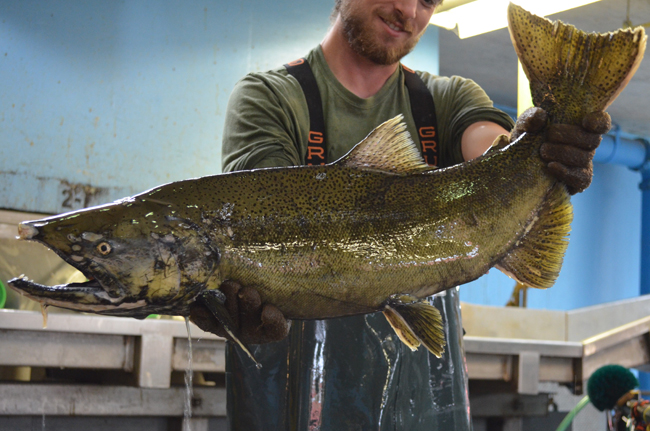
Chinook (“King”) Salmon collected in 2019 at the NYSDEC Salmon River Fish Hatchery in Altmar, NY as part of its stocking program while Cornell PhD candidate Kimberly Fitzpatrick (not pictured) was collecting genetic samples from every female fish processed by the hatchery so that their offspring could be identified as stocked fish. Credit: Kimberly Fitzpatrick
Monitoring Against Runaway Wild Production: Genetics Provides a Cost-Efficient and Reliable Tool for Identifying Hatchery Versus Wild Chinook Salmon in the Great Lakes (R/XG-31, Dr. Suresh Sethi, Cornell University)
Chinook (“King”) salmon are an important recreational fishery in Lake Ontario that provide significant cultural and economic benefits to New York anglers and surrounding communities. However, the stability of this fishery is closely tied to the balance between prey availability and salmon predation pressure within the lake. To maintain this balance, managers annually adjust salmon stocking levels in response to changes in the amount of available prey fish within the lake. However, while the number of stocked salmon can be precisely regulated by Lake Ontario managers, the number of naturally reproduced (“wild”) Chinook salmon can exceed the number of stocked and possibly place unstainable levels of predation pressure on the prey fish population and possibility threaten the viability of the Chinook salmon fishery.
A research project led by Dr. Suresh Sethi at Cornell University developed a genetic panel of novel markers for Chinook salmon to distinguish between stocked and wild salmon in the lake. This genetic tool can be used to accurately adjust stocking levels. The research team correctly identified the natal origin of >95% of offspring samples in the study.
This research lays the foundation for implementing a cost-efficient and accurate monitoring program for distinguishing between stocked and naturally reproduced Chinook salmon in Lake Ontario. These results have been shared with New York State Department of Environmental Conservation (NYSDEC) and the Ontario Ministry of Northern Development, Mines, Natural Resources and Forestry (NDMNRF) who are testing the technology.
More:
Electronically Monitoring Salmon Could Help Us To Better Understand Them (April 2020)
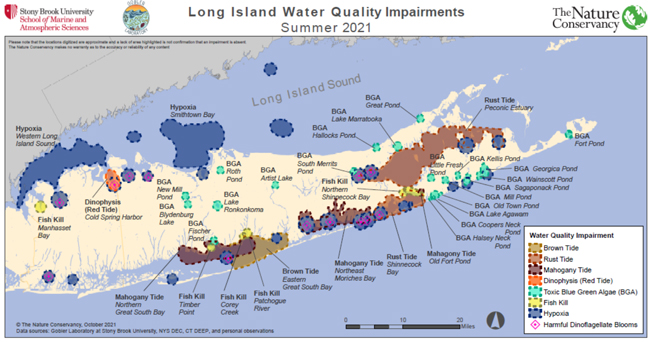
Blue-green algae blooms in inland freshwater lakes are caused by Microcystis, a potent gastrointestinal toxin. This toxin is unsurprisingly also harmful to small animals such as pet dogs that like to enjoy the waters around Long Island. Other blooms that plague Long Island waters (as featured in the summer 2020 map) include mahogany tide, rust tide, and brown tide – all of which bring negative impacts. Credit: Christopher Gobler
The Quantitative Contribution of Sedimentary Nutrient Fluxes to Nitrogen Loading and Harmful Algal Blooms in Long Island Estuaries (R/CMB-44, Dr. Christopher Gobler, Stony Brook University)
In Summer 2021, the Gobler Laboratory monitored a brown tide in the waters of Long Island’s Great South Bay near Patchogue. Caused by the Aureococcus anophagefferens alga, this HAB is highly damaging to marine life, especially eelgrass that fish and shellfish depend on for habitat.
The enrichment of Long Island’s coastal waters with nitrogen based nutrients has led to the progressive degradation of Long Island’s coastal environments for the last several decades. Impacts have included increased incidences of harmful algal blooms (HABs), hypoxia, and reduced bivalve populations. In response to this degradation, NYS and Suffolk County have taken management actions to reverse these trends. However, an important knowledge gap has emerged that may represent a significant obstacle in the planned remediation of Long Island estuaries: A quantitative understanding of the benthic exchanges of nutrients from sediments to the water column of NY estuaries and their role in promoting HABs.
A project led by Dr. Christopher Gobler at Stony Brook University sought to fill these knowledge gaps. The research team studied eight different HAB events in three Long Island bays while also measuring sediment nitrogen exchanges. In addition lab experiments were conducted to assess the ability of sediment exchanges from muds and sands to influence the occurrence of HABs.
Results expanded understanding of nitrogen loading to Long Island estuaries. Sediment exchanges appear to be the largest or second largest source of nitrogen to the estuaries considered here. Models have shown that, at least for some cases, mitigating both sediment exchanges and watershed-based nitrogen loads will be needed to mitigate HABs. These findings will need to be incorporated into ongoing nitrogen management and mitigation scenarios by NYSDEC, Suffolk County, and Nassau County. In the end, the findings may lead to the requirement of significantly larger reductions in nitrogen for estuaries than previously anticipated.
More:
Reporting Suspicious Marine Algal Blooms
On YouTube: HABs A Summer of Discontent in Long Island's Coastal Waters (October 2021)
In Photos, On YouTube: State of the Bays — 2021 (July 2021)
In Media: Cultivating Kelp Will Help Cut Down Nitrogen in Local Waters (June 2021)
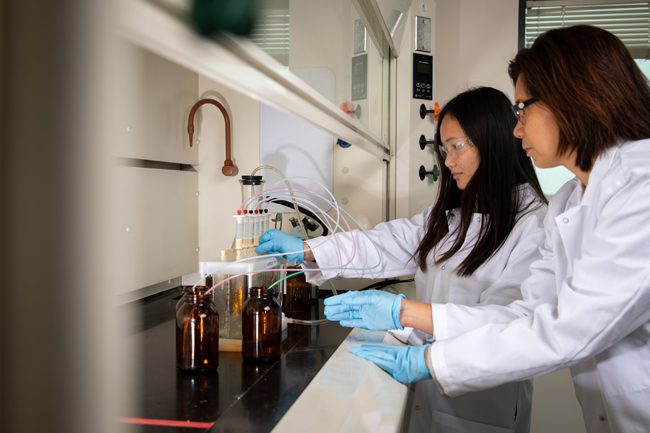
UB chemistry professor Diana Aga (right) and UB chemistry PhD candidate Luisa Angeles in the lab. To study pharmaceuticals in wastewater, they use the system pictured to isolate chemical compounds from the wastewater. Credit: Meredith Forrest Kulwicki
Pharmaceuticals in New York Waters: Effectiveness of Advanced Treatment Options, Environmental Levels and Potential Effects (R/CTP-54, Dr. Anne McElroy, Stony Brook University; Dr. Diana Aga, University at Buffalo)
The release of pharmaceuticals into surface waters has become an issue of concern world-wide. With more sensitive methods, scientists have reported detectable levels of drugs in many surface waters, but we don’t really know if the low levels detected are likely to cause harm to aquatic organisms. Traditional wastewater treatments were not designed to remove many drugs which are more water soluble than the typical pollutants currently regulated.
A research project led by Dr. Anne McElroy at Stony Brook University and Dr. Diana Aga at University at Buffalo sought to evaluate the effectiveness of newer advanced methods to remove neuroactive pharmaceuticals. The research team also sought to evaluate potential effects of these pharmaceuticals by screening their ability to alter behavior in fish, and by evaluating waste water treatment plant (WWTP) effluents to alter fish behavior.
Results found that advanced treatments, specifically activated carbon and ozonation were most effective in removing pharmaceuticals from wastewater. The fish behavior results showed that none of the effluents from the WWTP sampled had any short term effect on fish behavior. Although no short term behavioral effects associated with environmentally realistic levels of these drugs were found, chronic effects should still be evaluated. The results of this project can be useful to WWTP districts considering upgrades to their treatment processes.
“Our research adds to a growing body of work showing that advanced treatment methods, including ozonation and activated carbon, can be very effective at removing persistent pharmaceuticals from wastewater,” said McElroy.
More:
In Media: Study Examines How Sewage Plants Can Remove Medicines from Wastewater (January 2020)
Study Examines Efficiency of Medicine Removal from Wastewater Treatment Plants (January 2020)
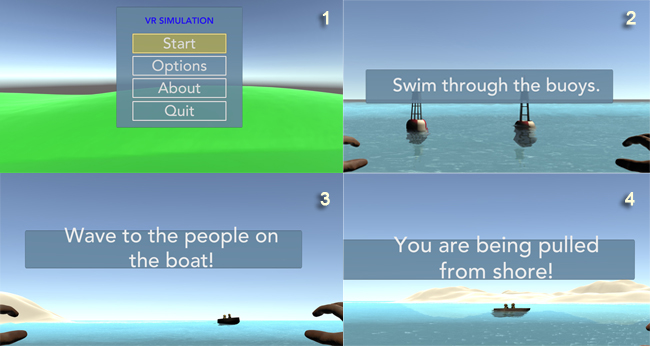
Broadcast journalists (including ones from Fox 5 and CBS 2 News) covered PI Jase Bernhardt’s work at Point Lookout beach in July 2019. Credit: Jase Bernhardt
Enhancing Rip Current Awareness with Virtual Reality (R/CHD-14, Dr. Jase Bernhardt, Hofstra University)
Rip currents are one of the leading causes of weather fatalities in the United States, yet they are not well understood by the public. Improving public understanding of the risks of rip currents and what to do when caught in one will improve public safety.
A project led by Dr. Jase Bernhardt at Hofstra University tested the use of virtual reality technology to improve public understanding of rip currents. The research team developed and tested the effectiveness of a virtual reality simulation in which an individual is caught in a rip current and must choose the best course of action. The goal was to show through surveys that such a simulation is a meaningful way to train the public to take rip current risk seriously and learn how to stay safe when impacted. The project developed a virtual reality (VR) simulation wherein participants are trained in how to use the equipment and then caught in a rip current without warning. The mitigating action taken by the player to escape the rip current was recorded, along with follow-up interviews about the usefulness of the VR and the reasons for their selected action.
The results of this work provide invaluable insight into the behavioral responses when caught in a rip current and proved that VR is a memorable and engaging way to convey hazard risk. “By leveraging an innovative technology—a virtual reality video game—we aim to improve public understanding of rip current risk and the proper actions to take if caught in one,” said Bernhardt. “If you make a video game, and ask people to get in there, and actually do it, hopefully, the lesson will make a deeper impression.”
More:
Do You Lifeguard at a Long Island Beach? NYSG and MARACOOS Needs Your Feedback (Summer 2022)
On YouTube: Virtual Reality Game Teaches Beachgoers Hazards of Rip Currents (December 2020)
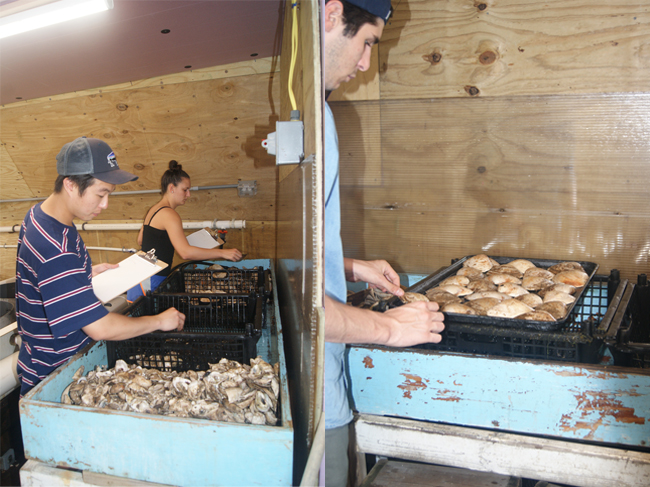
Sea Grant student interns count the number of whole shells of oysters, which, along with other types of shellfish, are raised in a facility run by a small group of Cornell Cooperative Extension staff and volunteers. Credit: Michael Ciaramella/NYSG
Transcriptomic Identification of Candidate Genes for Rapid Assessment of Plastic Marine Debris Exposure in Eastern Oysters (Crassostrea virginica) (R/XG-30, Dr. Laura Eierman, SUNY Cortland)
Concern has been growing over the potential impacts of plastic pollution on coastal environments. Plastics pose a complex threat through the sorption of harmful organic pollutants, release of complex chemical ingredients that compose plastics, and fragmentation of plastic pieces.
The eastern oyster (Crassostrea virginica) is a keystone species in New York estuaries that creates habitat and serves as shoreline protection. Previous research has found that eastern oysters grown on pieces of polyethylene terephthalate (PET) plastic had a significantly skewed sex ratio towards more females than observed in oysters grown on shell.
A research project led by Dr. Laura Eierman at SUNY Cortland identified candidate genes in eastern oysters responsive to plastic pollution exposure that may be responsible for the observed female-shift in sex ratio. Hatchery-produced larval oysters were settled onto either oyster shell or PET plastic in a settling tank and placed on natural reefs.
Results showed that genes involved in gametogenesis had altered expression in response to plastic exposure compared to oysters of the same sex grown on shell. Oysters grown on plastic had a significantly lower proportion of males compared to oysters grown on shell skewing the sex ratio towards females. Juvenile oysters grown on PET showed significantly higher mortality rates and slower growth rates than those grown on shell. These findings suggest deleterious impacts of plastic exposure on the survival, growth, and, potentially, the reproduction of oysters. These results suggest that we may reconsider some standards of oyster restoration such as the use of plastic mesh bags of shell to rebuild reef structure.
More:
Molecular Adaptation and Selection in Oysters (May 2022)
NYSG Research: Journal Articles Roundup (May 2022)
More Info: New York Sea Grant
New York Sea Grant (NYSG), a cooperative program of Cornell University
and the State University of New York (SUNY), is one of 34 university-based
programs under the National Oceanic and Atmospheric Administration’s
National Sea Grant College Program.
Since 1971, NYSG has represented a statewide network of integrated
research, education and extension services promoting coastal community
economic vitality, environmental sustainability and citizen awareness
and understanding about the State’s marine and Great Lakes resources.
Through NYSG’s efforts, the combined talents of university scientists
and extension specialists help develop and transfer science-based
information to many coastal user groups—businesses and industries,
federal, state and local government decision-makers and agency managers,
educators, the media and the interested public.
The program maintains Great Lakes offices at Cornell University, SUNY
Buffalo, SUNY Oswego and the Wayne County Cooperative Extension office
in Newark. In the State's marine waters, NYSG has offices at Stony Brook
University in Long Island, Brooklyn College and Cornell Cooperative
Extension in NYC and Kingston in the Hudson Valley.
For updates on Sea Grant activities: www.nyseagrant.org has RSS, Facebook, Twitter, Instagram, and YouTube links. NYSG offers a free e-list sign up via www.nyseagrant.org/nycoastlines for its flagship publication, NY Coastlines/Currents, which is published quarterly.